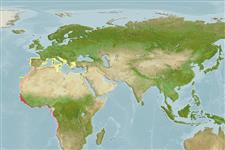Classification / Names
Common names from other countries
Main reference
Size / Weight / Age
Max length : 147 cm TL male/unsexed; (Ref. 36897); common length : 80.0 cm TL male/unsexed; (Ref. 3261)
Environment
Marine; brackish; demersal; depth range 0 - 100 m (Ref. 12951)
Climate / Range
Subtropical, preferred ?; 44°N - 17°S, 19°W - 36°E
Distribution
Short description
Dorsal
spines
(total): 0;
Anal
spines: 0;
Anal
soft rays: 0. Rostral ridges widely separated over their entire length; anterior nasal lobe reaching to level of inner corner of nostril, posterior nasal flap wide; spiracle with two moderately developed folds, the outer one more prominent; thorns relatively small, present around inner margin of orbits, between spiracles, on shoulders, and along midline of disc and tail; Upper surface khaki-brown, underside white (Ref. 6675).
IUCN Red List Status (Ref. 115185)
Threat to humans
Harmless
Human uses
Fisheries: commercial
More information
ReferencesAquacultureAquaculture profileStrainsGeneticsAllele frequenciesHeritabilityDiseasesProcessingMass conversion
Tools
Special reports
Download XML
Internet sources
Estimates of some properties based on models
Phylogenetic diversity index
PD50 = 0.5000 many relatives (e.g. carps) 0.5 - 2.0 few relatives (e.g. lungfishes)
Trophic Level
4.1 ±0.5 se; Based on diet studies.
Resilience
Very Low, minimum population doubling time more than 14 years (Fec=4)
Vulnerability
High to very high vulnerability (68 of 100)
Price category
